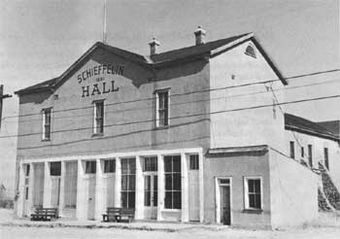Schieffelin Hall facts for kids
Quick facts for kids |
|
|
Schieffelin Hall
|
|
|
U.S. National Historic Landmark District
Contributing Property |
|

Schieffelin Hall
|
|
| Location | 215 N 5th St., Tombstone, Arizona |
|---|---|
| Built | 1881 |
| Built by | Albert Schieffelin and William Harwood |
| Architectural style | Adobe construction |
| Part of | Tombstone Historic District (ID66000171) |
| Designated NHLDCP | July 4, 1961 |
Schieffelin Hall is a very old building in Tombstone, Arizona Territory. It was built in 1881. This building is the largest standing adobe structure in the southwestern United States. Adobe means it was built using sun-dried earth bricks.
Albert Schieffelin, whose brother Ed Schieffelin founded Tombstone, built it with William Harwood. They wanted it to be a fancy opera house, a theater, a place for music, and a meeting spot for everyone in Tombstone.
Contents
History of Schieffelin Hall
Schieffelin Hall opened its doors on June 8, 1881. It was located at the corner of Fremont and Fourth Streets. The main floor could hold 450 people, and the balcony could hold 125 more. The stage curtain had a beautiful painting of a scene from Colorado.
A Hub for Entertainment
This hall quickly became the main place for fun and social events in Tombstone. People enjoyed formal dances and exciting plays there. When it first opened, it was the biggest and fanciest theater between El Paso, Texas, and San Francisco, California. The very first play performed was The Ticket-of-Leave Man on September 15, 1881. A big fire in 1882 damaged many parts of the town, including the hall.
The Schieffelin Brothers' Story
Albert Schieffelin, his brother Ed, and their friend Richard Gird were partners in mining. They made a deal with a handshake, which meant they trusted each other without needing a written contract. Their company, the Tombstone Gold and Silver Mining Company, owned several mines. They found a lot of silver and gold, making millions of dollars.
Albert Schieffelin used some of his wealth to build Schieffelin Hall. This shows how important mining was to the growth of Tombstone.
Masonic Lodge Meeting Place
King Solomon Lodge #5 is a very old group of Masons in Arizona. They started meeting upstairs in the Masonic Hall on March 14, 1881. Wells Spicer, a local judge, was the first leader of this lodge. He was also involved in the famous events surrounding the Earps and Doc Holliday.
Building Schieffelin Hall
The main entrance of Schieffelin Hall is on Fourth Street. It is about 119 feet long and 59 feet wide. The walls are very thick, about 16 inches. The whole building stands about 40 feet tall.
Inside the Hall
The main entrance leads to a large auditorium. This room is about 39 feet by 59 feet. It could seat 450 people on the main floor and 125 in the balcony. The stage is also quite large, about 30 feet by 59 feet. The stage curtain is 24 feet wide and 21 feet high.
Second Story Features
The part of the building facing Fremont Street is 59 feet long. It has another entrance. The first floor is 14 feet high and 30 feet deep. The second floor is 16 feet high. It holds the Masonic Hall, which is about 27 feet by 41 feet. There are also three smaller rooms next to it.
Restoring the Historic Building
Schieffelin Hall was not taken care of for many years after 1917. In 1964, a group of investors bought the hall and other famous places in Tombstone.
Bringing it Back to Life
In 1963, a group called Historic Tombstone Adventures started to fix up and restore the hall. Their goal was to save many of the town's important buildings. On October 15, 1966, Schieffelin Hall was added to the National Register of Historic Places. This is a list of buildings important to American history. In 1979, the group gave the building to the city of Tombstone.
More work was done between 1990 and 1994. The outside of the building was fixed, the foundation was made stronger, and new window frames were put in. In 1999, the adobe walls were repaired, and the floors inside were redone. In 2015, the Arizona Department of Transportation helped rebuild the porch in front of the building. They even made new bricks using old methods to match the original look!
Current Uses of Schieffelin Hall
Today, Schieffelin Hall is still a busy place. It is used for:
- Plays and other performances
- City council meetings
- Local social gatherings
- Fundraisers for good causes
It is still the home of the King Solomon Lodge #5. Schieffelin Hall is an important part of the Tombstone Historic District. This district is also listed on the National Register of Historic Places.
Albert Schieffelin's great-niece, Mary Schieffelin Brady, helped reopen the hall in 1964. It continues to be a popular attraction in Tombstone. It is still the largest standing adobe building in the southwestern United States.
Gallery





